Did you find yourself flustered in an emergency due to limited first aid supplies? Do not worry; we will tell you exactly what you need in your first aid kit. We understand that having a well-stocked first aid kit can mean the difference between a quick recovery and a trip to the hospital.
We do not want your house to be a part of the 44% that do not have fully stocked medical kits. Thus leaving them unprepared for common and critical medical emergencies. Let’s analyze the essential items every kit should include and how you can create a personalized kit for your situation.
Key Takeaways
- A home first aid kit should be comprehensive, containing essential medications, bandages, and antiseptic solutions tailored to common injuries and emergencies.
- Specialized first aid kits, including those for workplace, trauma, and outdoor activities, are critical for addressing specific risks and ensuring preparedness in diverse environments.
- Regular maintenance and checkups of your first aid kit are essential to ensure it is well-stocked, functional, and ready for use in emergencies.
Essential Items in a First Aid Kit
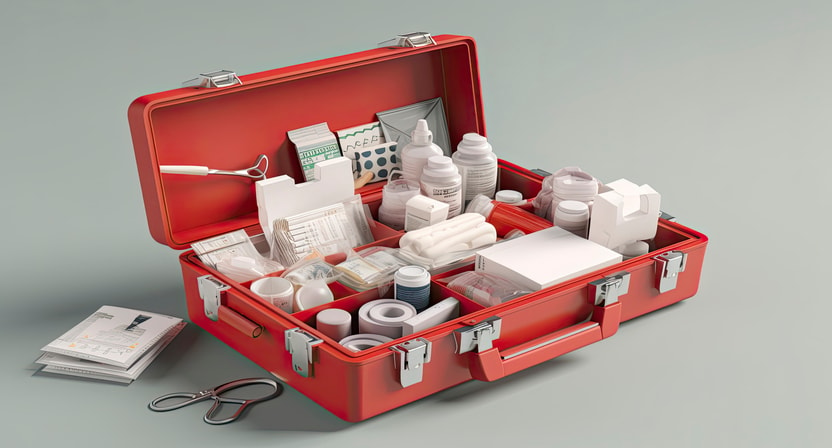
Replace image.Add from Pixabay, select from your files or drag and drop an image here.
A well-stocked home first aid kit is a cornerstone of household safety. It should contain a variety of supplies to address common injuries such as cuts, burns, and sprains, as well as essential medications and items like adhesive bandages, antiseptic wipes, and emergency contact information. A comprehensive kit prepares you for various scenarios, offering peace of mind and enabling swift action in emergencies.
The key components of a first aid kit can be divided into three main categories: Medications, Bandages and Dressings, and Antiseptic Solutions and Disposables. Each category ensures your kit is ready for different injuries and medical situations.
Medications
Medications in a first aid kit offer pain relief and treat common symptoms. Essential medications include painkillers like aspirin and acetaminophen, which are useful for reducing fever and alleviating pain. However, it’s important to remember that aspirin should not be given to children, individuals allergic to it, or those with certain medical conditions.
Life-saving medicines, such as epinephrine, are essential for treating severe allergic reactions like anaphylaxis. Keeping these medications on hand can help prevent a potentially fatal crisis from becoming complicated before medical help with stretchers arrives.
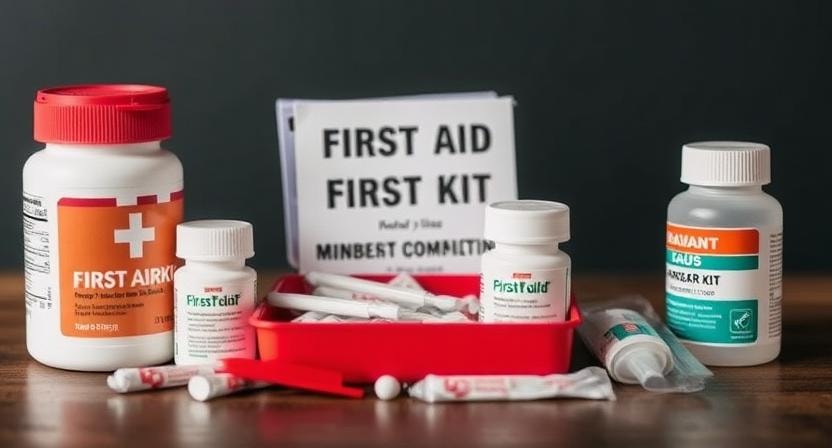
Replace image.Add from Pixabay, select from your files or drag and drop an image here.
Furthermore, personalizing drug choices to your family’s individual needs, such as including antihistamines for allergies or glucose pills for diabetics, ensures your kit provides the appropriate level of care. It is one of the core suggestions of the Red Cross emergency kit, to have medications that cater to your individual needs handy.
Bandages and Dressings
Bandages and dressings are essential, offering protection and aiding wound healing. A well-equipped kit includes adhesive bandages of various sizes for minor cuts and abrasions. Compress dressings manage larger wounds, control bleeding, and prevent infection.
Workplace first aid kits, following ANSI recommendations, should be stocked with basic supplies, including various types of bandages and antiseptics. Cotton balls and calamine lotion can be added for soothing skin irritations and cleaning wounds.
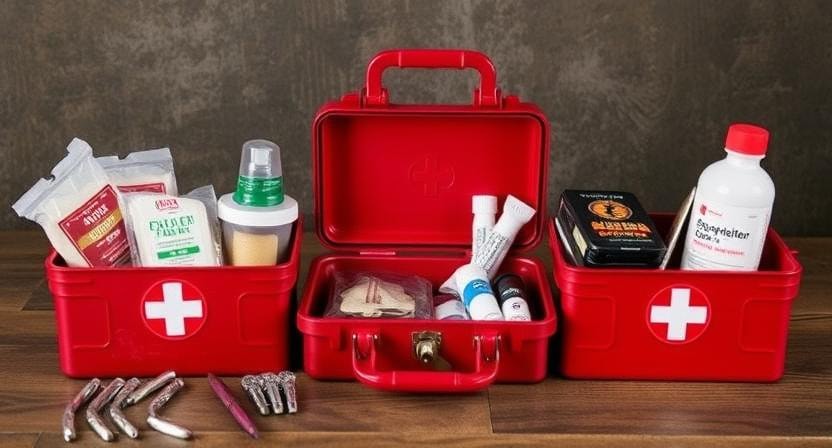
Replace image.Add from Pixabay, select from your files or drag and drop an image here.
Antiseptic Solutions and Disposables
Preventing infection is a critical aspect of first aid, making antiseptic solution and disposables indispensable components of any kit. Antiseptic wipes and hydrogen peroxide assist in cleaning wounds and reduce the risk of infection, while hand sanitizer ensures hygiene before and after treatment. In addition, antibiotic ointments can help to prevent bacterial growth.
Personal protective equipment, like disposable gloves and tweezers, is essential for managing wounds properly and preventing cross-contamination. Ensuring that your kit contains these items in assorted sizes improves both safety and effectiveness during crises.
Specialized First Aid Kits
While a standard first aid kit is essential for home use, specialized kits are designed to meet the unique needs of different environments and activities. Whether you’re at work, enjoying outdoor adventures, or preparing for emergencies, selecting the appropriate first aid kit is crucial. These kits are tailored to address specific risks and injuries that may occur in various settings.
We will explore specialized first aid kits for workplaces, trauma and tactical situations, and travel and outdoor activities. Each type of kit is designed with specific components to ensure safety and preparedness in diverse environments.
Workplace First Aid Kits
Workplace first aid kits meet the specific needs of various job environments, ensuring access to essential medical supplies in case of injuries. OSHA requires that workplaces maintain the availability of first aid equipment, with the contents of these kits matching the potential risks associated with specific job tasks.
They should include items like non-latex gloves to protect both caregiver and patient during treatment. The type of first aid facilities required depends on job types and potential injuries. A well-stocked workplace first aid kit can significantly reduce the impact of injuries.
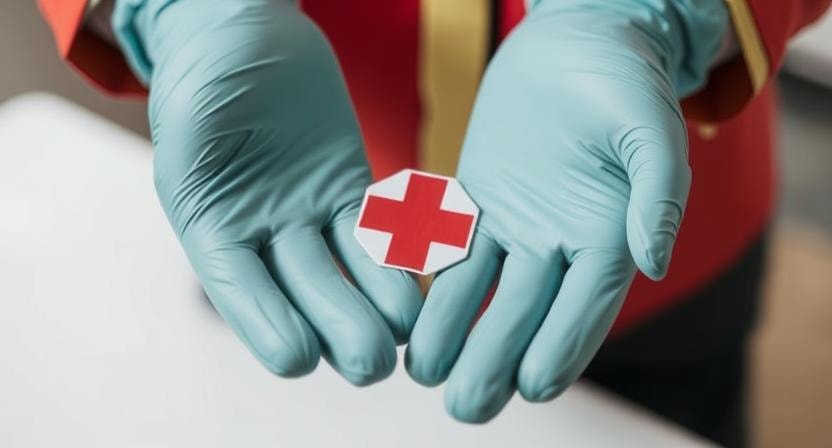
Replace image.Add from Pixabay, select from your files or drag and drop an image here.
Trauma and Tactical Kits
Trauma and tactical kits handle severe injuries and include advanced medical supplies. They typically contain pressure bandages and hemostatic gauze for managing major wounds and controlling severe bleeding. Advanced items such as chest seals and combat tourniquets reflect modern medical advancements.
Modern first aid kits incorporate advanced materials and specialized medications for enhanced treatment, ensuring preparedness for critical situations. A trauma and tactical kit on hand can be life-saving in emergencies, especially in high-risk environments.
Travel and Outdoor Kits
Travel and outdoor first aid kits are crucial for activities like hiking, camping, and boating. Designed to be portable and robust, these kits ensure readiness for injuries in varying conditions. Waterproof bandages, emergency blankets, and instant cold packs are crucial for outdoor injuries.
These kits should also contain splints and blister treatment for specific injuries common in sports and camping. A specialized outdoor first aid kit enhances safety and preparedness, allowing peace of mind during adventures.
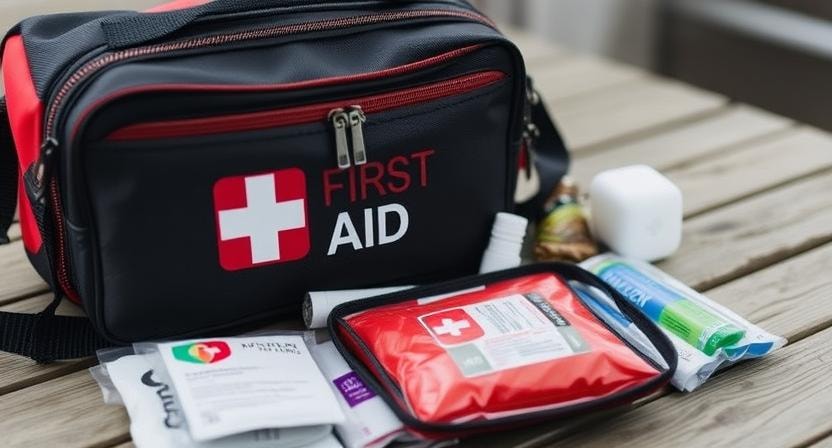
Replace image.Add from Pixabay, select from your files or drag and drop an image here.
Maintaining Your First Aid Kit
Regular maintenance of your first aid kit ensures it is always ready for emergencies. Frequent checks and restocking significantly enhance your preparedness. Adding personal items like medications and emergency contact details enhances the effectiveness of your kit.
We will discuss the importance of regular checkups and offer tips on easy refilling and restocking to keep your first aid kit functional and organized.
Regular Checkups
Regular checking can help keep your first aid kit stocked and effective. Examine the kit for expired drugs, depleted supplies, and defective tools, such as dead flashlight batteries. Keeping a checklist of necessary products and recording the most recent inspection date will make refilling easier and ensure you’re always prepared for an emergency. You can attach a page to the emergency kit or bag to keep everything in order
Easy Refill and Restock
Keeping a well-stocked first aid kit is simple. Durable materials in your first aid kit enhance longevity and reliability. Sections for personal items streamline restocking and make it easier to track replacements.
Conveniently purchase individual items to refill your kit without replacing everything, keeping it well-stocked and organized. Regular updates and restocking ensure you are always prepared for emergencies.
Historical Evolution of First Aid Kits

Replace image.Add from Pixabay, select from your files or drag and drop an image here.
First aid kits have certainly come a long way since their introduction in the late 1800s. Early kits were not as effective because of limited supplies. Understanding this history helps us appreciate the importance of up-to-date first-aid practices.
We will explore the contents and limitations of early first aid kits and the modern advancements transforming them into comprehensive lifesaving collections.
Early Kits
Most early kits only had basic materials such as snakebite kits, which current research has proved to be insufficient. Supplies were largely designed to heal superficial wounds rather than more serious ones. As medical knowledge advanced, first aid kits expanded to incorporate more specialized and scientifically supported elements, resulting in enhanced efficiency in emergency situations.
The evolution to more advanced kits underscores progress in understanding and addressing medical emergencies. Keeping up with advancements ensures your first aid kit remains effective and reliable.
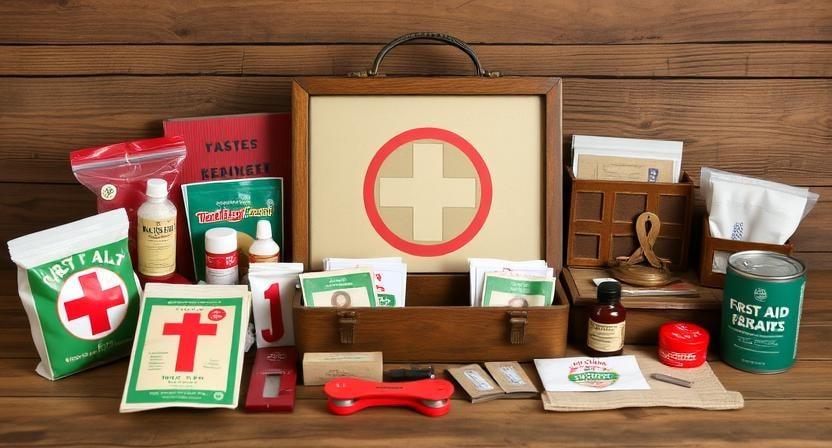
Replace image.Add from Pixabay, select from your files or drag and drop an image here.
Modern Advancements
Modern first aid kits include components for life-saving procedures. Items like CPR face shields and body-fluid barriers enhance safety during resuscitation, reflecting advancements in first aid practices. The removal of outdated items like mercurochrome shows a commitment to safety and effectiveness.
These advancements have made first aid kits more comprehensive and capable of handling diverse medical situations. Incorporating the latest medical knowledge and technology ensures you are well-prepared to provide effective care in emergencies.
Choosing the Right First Aid Kit for Your Needs
Choosing the appropriate first aid pack is determined by your environment, location activity, and possible risks. Whether for home, work, vacation, or outdoor adventures, choosing a kit with the correct items ensures you’re ready for unexpected events in any situation. It is also important to factor in the number of people relying on the medical kit.
Understanding the specific hazards you may face, such as burns in the kitchen, sprains during sports, or dehydration while hiking, allows you to design your kit for maximum effectiveness. We will guide you through selecting the best first aid kits for home use, car and travel, and sports and outdoor activities.
Home Use Kits
Home use first aid kits should be comprehensive, including items for emergencies like trauma or allergic reactions. The Johnson & Johnson All-Purpose kit is highly regarded for its ample supply of bandages and basic medications. A well-stocked home first aid kit addresses a variety of everyday injuries and emergencies.
These kits should include various supplies to handle common household injuries, ensuring preparedness to prepare for any home situation.
Car and Travel Kits
Travel first aid kits are compact, making them ideal for vehicles or while traveling. They typically include lightweight supplies for easy carrying on outdoor adventures. Items like instant cold packs and small bandages address travel-related injuries.
The Homestuck + Professional, designed for road trips, features a robust organization system to carry for quick access. A compact and portable travel first aid kit ensures preparedness for any medical situation on the go.
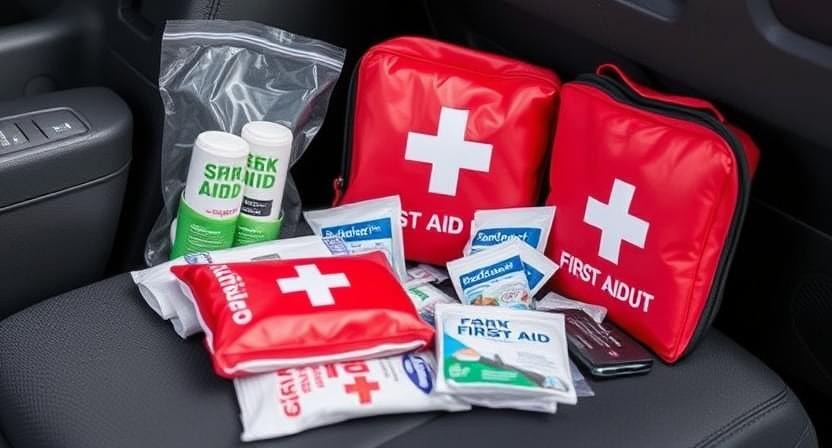
Replace image.Add from Pixabay, select from your files or drag and drop an image here.
Sports and Outdoor Activities
For frequent sports and outdoor activity enthusiasts, specialized first aid kits are essential. These kits address injuries common in such activities, including fractures, sprains, and severe bleeding. The Adventure Medical Kits Mountain Series Hiker is popular for its compact size and essential supplies for minor injuries.
Outdoor kits often feature insect repellent, specialized dressings for wounds, and instant cold packs for injuries during hiking, camping, or other adventures. A well-prepared kit tailored to your activities ensures safety and preparedness, allowing confidence in outdoor experiences.

Replace image.Add from Pixabay, select from your files or drag and drop an image here.
Summary
In conclusion, having a well-stocked and properly maintained first aid kit is crucial for ensuring safety and preparedness at home, in the workplace, and during travel or outdoor activities. From essential medications and bandages to specialized kits for various environments, understanding what to include in your first aid kit can make all the difference in an emergency. Regular checkups and easy restocking practices further enhance the reliability and effectiveness of your kit.
As we’ve explored, the evolution of first aid kits reflects significant advancements in medical knowledge and technology. By choosing the right kit for your needs and keeping it up-to-date, you can ensure that you’re always ready to handle any situation that arises. Stay prepared, stay safe, and take the necessary steps to protect yourself and your loved ones.
Frequently Asked Questions
What should be included in a basic home first aid kit?
A basic home first aid kit must contain adhesive bandages, antiseptic wipes, pain relievers like aspirin or acetaminophen, emergency contact information, and supplies for managing common injuries such as cuts, burns, and sprains. This ensures preparedness for minor medical situations.
How often should I check and restock my first aid kit?
You should check and restock your first aid kit at least every six months to ensure all items are current and usable. Regularly documenting the last inspection date will aid in maintaining an effective kit.
What makes a workplace first aid kit different from a home kit?
A workplace first aid kit is specifically designed to address job-related risks and injuries, incorporating items required by OSHA and tailored to the hazards of the work environment. In contrast, a home kit typically includes more general first aid supplies, reflecting the different types of risks encountered in domestic settings.
Why are trauma and tactical kits important?
Trauma and tactical kits are crucial for effectively managing severe injuries and controlling significant bleeding through advanced medical supplies. Their importance lies in the ability to provide immediate and potentially life-saving care in critical situations.
What should I look for in a travel or outdoor first aid kit?
When selecting a travel or outdoor first aid kit, ensure it is compact and portable, containing essential items such as waterproof bandages, emergency blankets, and instant cold packs to address common injuries encountered during outdoor activities.
Stay Prepared with High-Quality First Aid Kits!
Ensure safety at home, work, or on the go with Jiekang’s premium first aid kits and medical supplies. Whether you need a comprehensive home kit, workplace essentials, or specialized trauma supplies, we provide reliable, durable solutions to keep you and your loved ones safe. Don’t wait until an emergency happens, ensure you have the right supplies on hand today. Contact usnow to find the perfect first aid kit for your needs!



